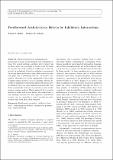Feedforward architectures driven by inhibitory interactions
Author(s)
Billeh, Yazan N.; Schaub, Michael T
Download10827_2017_669_ReferencePDF.pdf (4.245Mb)
PUBLISHER_POLICY
Publisher Policy
Article is made available in accordance with the publisher's policy and may be subject to US copyright law. Please refer to the publisher's site for terms of use.
Terms of use
Metadata
Show full item recordAbstract
Directed information transmission is paramount for many social, physical, and biological systems. For neural systems, scientists have studied this problem under the paradigm of feedforward networks for decades. In most models of feedforward networks, activity is exclusively driven by excitatory neurons and the wiring patterns between them, while inhibitory neurons play only a stabilizing role for the network dynamics. Motivated by recent experimental discoveries of hippocampal circuitry, cortical circuitry, and the diversity of inhibitory neurons throughout the brain, here we illustrate that one can construct such networks even if the connectivity between the excitatory units in the system remains random. This is achieved by endowing inhibitory nodes with a more active role in the network. Our findings demonstrate that apparent feedforward activity can be caused by a much broader network-architectural basis than often assumed. Keywords: Feedforward networks, Inhibitory feedback, Leaky-integrate-and-fire Information propagation, Neural networks
Date issued
2017-11Department
Massachusetts Institute of Technology. Institute for Data, Systems, and SocietyJournal
Journal of Computational Neuroscience
Publisher
Springer US
Citation
Billeh, Yazan N., and Michael T. Schaub. “Feedforward Architectures Driven by Inhibitory Interactions.” Journal of Computational Neuroscience, vol. 44, no. 1, Feb. 2018, pp. 63–74.
Version: Author's final manuscript
ISSN
0929-5313
1573-6873